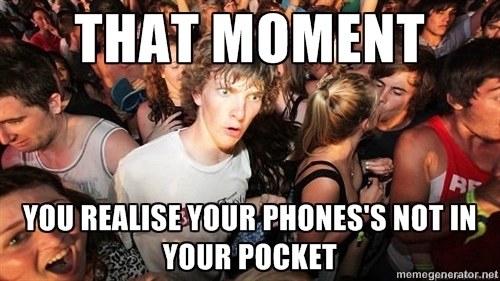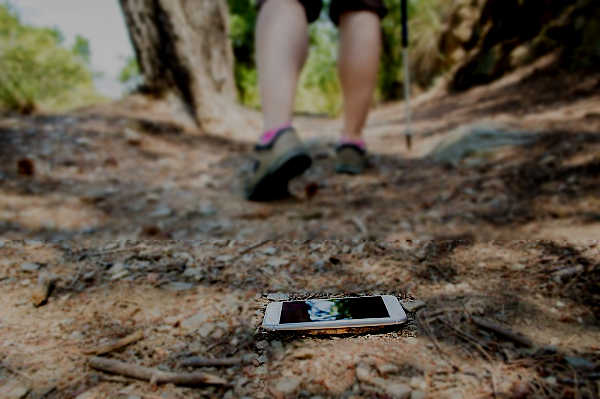My wife, Priya, and I were on a 3-month trip in the Himalayas. 25 days into the trip, I lost my smartphone. I carelessly left it behind on a bus and realised the folly only an hour later in our hotel room. The word ‘smartphone’ seems like just one object. However, it is much more. It was my my phone, our Internet connection, our reference book, our compass, etc. We had 65 days to go until we would be back to Mumbai, where I could get a duplicate SIM card. SIM cards are only replaced in a phone number’s home zone. I could have got a new smartphone and used it without the SIM, for other purposes like camera. But it didn’t make monetary sense to buy a smartphone from a showroom in Uttarakhand, when an Internet purchase can be much cheaper. Being on a backpacking trip and staying in different lodges every two or three days, I couldn’t even furnish a postal delivery address. So I decided not to buy a new phone until reaching Mumbai. In this post, I will narrate my experience of life without a smartphone for a little more than 2 months.
What I lost with the smartphone
My smartphone had a primary Vodafone SIM and a secondary Reliance Jio SIM. The Vodafone SIM was for connecting with my family, but more importantly to receive SMS messages for various validation purposes such as for banking. The Jio SIM was for high speed Internet connectivity whenever we were in bigger towns. The camera on the phone was good. While we were certainly carrying a DSLR camera, the phone was good to take a quick shot out of a bus window or when it was raining.
The GPS served as a guide post when we wanted to be sure about where we were headed, especially when exploring roads in towns. While the Himalayan highways have excellent road signs, the towns themselves are dismal at pointing the way to their key points of interest. Our’s was a self-planned trip with no guides. Google Maps came to our rescue several times.
The Internet connection was good to search out hotels or the way to places of interest. It was good for planning a list of destinations for the following day. Also, I was transferring photos from my DSLR to my laptop and frequently sharing all the pictures on Facebook and Instagram using the Jio Internet, wherever it was available. Then there were e-mails from my clients and a few project deliveries, which needed Internet. So with the loss of my smartphone, I lost quite a few features.
The effect on me

Fortunately for me, I have never been a chronic smartphone addict. Yes, given an option between doing nothing and peeking into my smartphone, I would choose the latter. But during my regular work life in Mumbai, I had a strict, no-distraction daily time-table with clear schedules on what to do throughout the day. So I routinely spent several hours a day not peeking into my smartphone out of impulse. It is only during 5-minute breaks in my schedule that I considered looking at my phone. I even had a 11 pm notification to switch off all my electronic screens (phone and laptop), since they interfered with my sleep.
During the trip, Priya had her smartphone and I could always borrow it for sometime if I needed something. It was depressing to lose my smartphone, but it was not the end of the world. After two weeks of not using a smartphone during my travel, I found it almost normal not to have one.
Here are the positive and negative effects on me after the phone loss.
The positive effects
The constant buzzing of a smartphone distracts us from or work at hand. Suddenly we spend 30 minutes of passive smartphone time, forgetting that we were working on something important and that we have been swayed. Several hours in a day are lost heeding the smartphone buzz. I had switched off notifications on all my distracting apps. E.g. my Facebook, WhatsApp and Instagram notifications were always off. Yet, the phone found reasons to grab my attention. When I lost my phone, the buzz effect was gone and I was spending my time, being present in whatever activity I was doing.

My aim was to use the DSLR for all photography, bearing a few misses. The convenience of the smartphone was making me reach out for it whenever I felt too bored to take my DSLR out of its camera bag. Also, the constant fiddling with the lens to get the right focus and zoom were making me ignore some good DSLR photo chances. I used the phone more frequently than I would have liked under the pretext that I could upload the photos on Facebook or Instagram instantly and do not have to wait for extracting them from the DSLR. With the phone lost, my only option was the DSLR and I was more committed to using its superior lens and other controllable options.
I could have more conversations with people around me. With no phone to get lost into, I was forced to talk to the people around me and had to rely on conversations to bide my time. I got to know more about the locals and about short-term and long-term travellers and their travel plans.
In the evenings, with no phone to peek into during our downtime at hotels, I was forced to think back in detail about our day and write better about our day of travel in my travel journal. Until I had my phone, I would want to get back to it for sometime to look at what comments our Facebook and Instagram photos had received. So my writing would be hasty and of much less detail. Thinking more about the day and writing more gave a detailed texture to my daily travel logs.
The negative effects
The first two days after losing the phone were spent in guilt. I was in a mode of ‘if only’ thinking, where I was reflecting upon how I lost the phone. I frequently reflected that the phone would have been safe with me, ‘if only’ I had done this or that. The smartphone was only 4 months old when I lost it, so there was a sense of frustration. I grew out of the frustration in 5 days, when I joined a ten-day long trekking activity.
One of my ATM cards had a PIN that did not work, but that bank account had more money than my other usable account, which was fast running out of cash as we spent on our travels. In fact, it was a long neglected bank account and had low balance to start with. Without a bank OTP on my mobile number, I could neither reset the ATM PIN online, nor transfer money out of the account flush with money. Online transactions using my credit cards were impossible too, since they too require an OTP validation. Using my digital wallet accounts like PayTM or ICICI wallet were also ruled out, since they needed their respective smartphone apps to make a payment. So the brunt of the expenses were born by Priya. She had to withdraw cash, pay for online purchases and use her digital wallet until we reached Mumbai. Luckily, one of my credit cards also sent OTPs to my email and I could use Priya’s phone and her working Internet connection to receive the OTP and contribute to some purchases. Also, I used my credit cards at shops or counters where credit cards were accepted, since swiping did not need OTP verification.
It was hard to keep in touch with new friends since I handed out my phone number to them, but could never get in touch. Sure, I could use Priya’s phone to call them up, but the more intuitive way of messaging them on Whatsapp was not available.
Takeaways
It is a difficult experience to lose one’s smartphone and find ways to fill the void. Banking and digital money are the worst affected facilities and for that reason alone, I’d keep my phone safe all the time. However I found some bright spots from not having a smartphone with me. More awareness about my surroundings, more engaging conversations with the people around me and more creative ways to fill the void. For this reason, I would consider switching my smartphone off for a day or two during my trips and then switch it back on again when I need to refer to something on the Internet, contact someone or pay for something online or use a digital wallet.

I really liked the part about what if’s and accepting the new reality. It is true for any loss situation in travel or in life.
Yeah, it already happened. So there was no point replaying it and making myself unhappy!